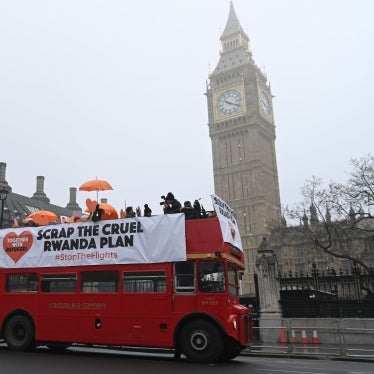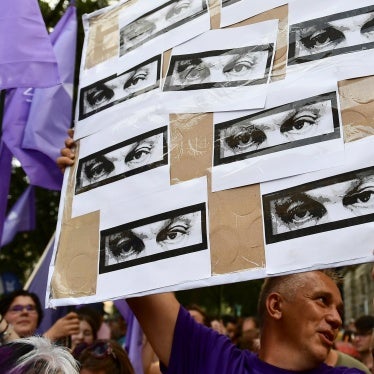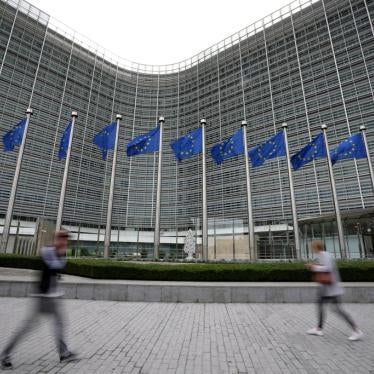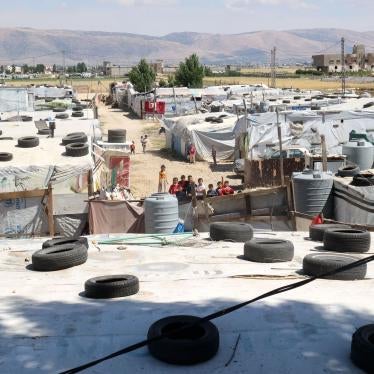The killing of unarmed protesters by the Uzbek government in Andijan last month was so extensive and unjustified that it amounted to a massacre, Human Rights Watch said today in releasing the most comprehensive investigation to date of the tragic events in eastern Uzbekistan.
The report, “Bullets Were Falling Like Rain”: The Andijan Massacre May 13, 2005, is based on 50 interviews with victims of and witnesses to the May 13 killings. It details the Uzbek government’s indiscriminate use of lethal force against unarmed people, describes government efforts to silence witnesses, and places the events against the background of Uzbekistan’s worsening human rights record.
Although armed men were present in Bobur Square during the shootings, the Uzbek government’s use of force against the crowd in the square was neither proportionate nor appropriate to the danger they posed, Human Rights Watch said.
“The Uzbek authorities are trying to whitewash this massacre,” said Kenneth Roth, executive director of Human Rights Watch. “Our investigation is a first step towards setting the record straight. But only a full-fledged international investigation, with access to official records, can give a true picture of the tragic events in Andijan.”
On May 13, 2005, thousands of people participated in a rare, massive protest in Bobur Square in the eastern Uzbek city of Andijan. It was initiated by a group of armed people who earlier in the day seized weapons at a military barracks and police station, led a prison break to free local businessmen unjustly accused of Islamic extremism, and took officials hostage in the local government building. Later the protest grew into a rally of thousands of people voicing their anger about growing poverty and government repression.
“The attackers committed serious crimes,” said Roth. “Of course the government had the right and the duty to stop them. But that doesn’t justify shooting unarmed people on a mass scale.”
Roth said that Human Rights Watch’s investigation left many questions, such as the true death toll, still unanswered. A thorough investigation into the killings should include ballistic, forensic and crime scene investigators, and should have access to hospital, morgue, and other official records.
The Uzbek government has rejected an international investigation, calling it unnecessary. Last week the Uzbek foreign minister said the government would allow foreign diplomats to monitor an investigation under way by the Uzbek parliament.
“The Uzbek government has a long record of censorship, repression, and impunity for human rights abuses,” said Roth. “And it has clearly tried to cover up the true scale and circumstances of the killings. An investigation led by the government, even with some limited international participation, would utterly lack credibility.”
Numerous witnesses interviewed separately told Human Rights Watch that government forces, some of them on armored personnel carriers and military trucks, fired indiscriminately into crowds where the overwhelming majority of people were unarmed. Some witnesses described one shooting incident in which security forces first shot into the air. But in all other shooting incidents described by eyewitnesses, no warnings were given, and no other means of crowd control were attempted.
After troops sealed off the area surrounding the square, they continued to fire from various directions as the protesters tried to flee. According to numerous witnesses and a few survivors, one group of fleeing protesters numbering up to 400 people was almost completely mowed down by government gunfire. Only a handful of people from the group of 400 survived.
In the aftermath of the events, Uzbek authorities forced a few journalists who were present in Andijan to leave, confiscated their materials, and effectively banned other journalists from entering the city afterwards.
Witnesses interviewed in Andijan clearly feared government retribution for speaking about the events. People said they had been explicitly warned by local law enforcement officials not to talk, and insisted that Human Rights Watch not release their names or any details that may allow the authorities to identify them.
Uzbek authorities deny responsibility for the killings. The government claims the death toll was 173 people—law enforcement officials and civilians killed by the attackers, along with the attackers themselves. The government says the attackers were “Islamic extremists” who had an Islamist agenda and help from abroad.
Human Rights Watch found no evidence that any of the speakers at the protest promoted an Islamist agenda. According to numerous witnesses, their grievances were overwhelmingly about poverty, corruption, and government repression. Eyewitness accounts suggest the number of dead to be far higher than the government figure.
Human Rights Watch urged the United States not to engage in any further discussions with Uzbekistan about a long-term arrangement for its military base there, and called on the European Union to suspend the EU Partnership and Cooperation Agreement until the Uzbek government allows an independent, international inquiry into the May 13 killings.







